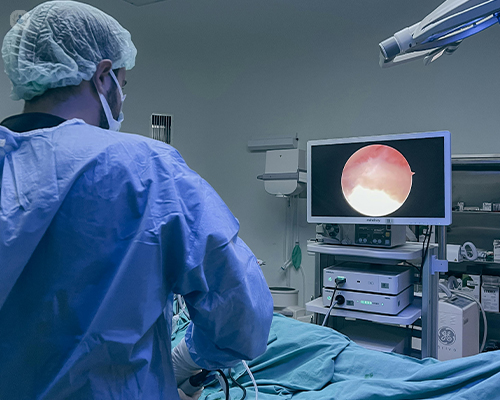Keyhole surgery: the key to a better surgical experience
Escrito por:Keyhole surgery is a surgical technique that is quickly becoming preferable for both patients and surgeons. In this article, a consultant orthopaedic surgeon explains the benefits of keyhole surgery.

What is keyhole surgery?
Keyhole surgery is a minimally invasive technique. Whereas traditional open surgery typically involves one large incision in order to allow surgeons access inside the body, a keyhole surgery only needs one or more deliberately placed, small incisions through which they insert surgical tools – one of the key tools is a long thin tube (flexible or rigid) that has a camera and a light called a scope attached to one end. The other end of the scope is connected to a screen in the operating theatre that will project the camera’s perspective, allowing surgeons to view the internal organs and structures in high definition and in real-time. Through other incisions, they will use tools like scalpels, needles, and forceps to investigate issues, remove blockages and harmful growths, seal and reattached ruptures and tears, and remove dysfunctional organs and tissues.
After the procedure, the tools are removed and the incisions are sutured and dressed in bandages. Most patients can go home on the same day.
What are the applications of keyhole surgery?
Depending on where the surgery is performed, it can be further categorised as a laparoscopy (abdominally), an arthroscopy (in the joints), or a thoracoscopy (in the chest). Many surgeries can be performed with the keyhole technique, including but not limited to:
- Cholecystectomy
- Hysterectomy
- Hernia repair
- Colectomy
- Bariatric procedures
- Tendon repair
- Ovarian cyst removal
What are the benefits of keyhole surgery?
Open surgery incisions are large and can take a long time to heal, leave a highly visible scar, and can lead to a lot of blood loss during the procedure. The benefits of keyhole surgery are that although there may be more incisions, they are smaller, meaning there is less blood loss, shorter recovery time, and smaller, less noticeable scars. Additionally, patients will have less pain and swelling as they heal and lower chances of contracting an infection or developing complications from the incisions because of their smaller size.
Keyhole procedures tend to be on the short side, ranging from 30 minutes to four hours, but this will depend on the nature of the procedure. Recovery time will also vary depending on the procedure, but patients generally can return to their normal activities within a couple of weeks as opposed to months.
What is the future of keyhole surgery?
Robotic assistance is steadily becoming more utilised for surgeries. Robotic surgery uses the same incisional technique as keyhole surgery, but has the advantage of being more dexterous and stable than human hands, allowing for access in hard-to-reach places. The technology is still developing and surgeons are still training on how to use robotic assistance, but perhaps one day, robotic keyhole surgery will become the new standard of surgical techniques.
To know more about keyhole surgery, consult with a specialist on Top Doctors.


